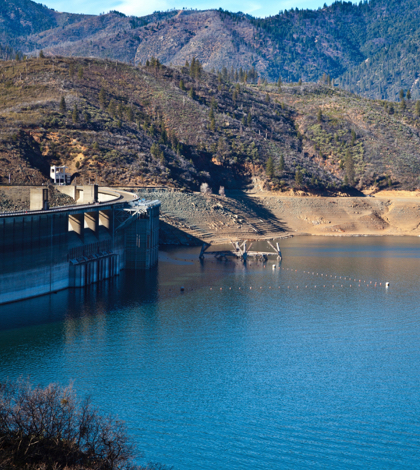Flood Control Safety Mandates in Effect
With El Nino making a significant showing in Northern California so far this calendar year, the state’s two largest reservoirs have begun releasing water to maintain flood-control safety.
The most current data on Lake Oroville and Lake Shasta reservoirs are shown to be at levels unseen in recent years. Lake Shasta is 110 percent of average for this time of year or 86 percent full; last year at this time it was 59 percent full. Likewise, Oroville is at 111 percent of average or 83 percent full vs. standing about half full a year ago.
Operators of the state’s reservoirs are required by the U.S. Army Corps of Engineers to maintain a buffer of empty flood control space in the reservoirs, based on the time of year. Although state reservoir operators say they would like to store as much water as possible they only have limited flexibility when it pertains to flood safety.
“We don’t have an option at this point; we’re in flood-control mode,” said Kevin Dossey, a senior engineer at the state’s Department of Water Resources, which operates Oroville.
The Lake Shasta reservoir began releasing considerable water earlier this week. This was the first flood-control release for the state’s largest reservoir in five years. For the first time since 2012, Lake Oroville began flood-control release procedures on Thursday. Oroville is California’s second largest reservoir.
Dossey referenced the flood-control releases from early 1997 at Oroville as topping 100,000 cubic feet per second. He indicated that this week’s releases were only targeted to be around 6,000 cubic feet per second.
Shane Hunt, with the U.S. Bureau of Reclamation which runs the Lake Shasta reservoir, indicted that earlier this week the lake was releasing about 20,000 cubic feet per second. That volume is expected to be dialed back to approximately 5,000 cubic feet per second by Monday.
Lake Oroville serves the State Water Project whereas Lake Shasta is part of the federal government’s Central Valley Project. Like most of California’s major reservoirs, both Shasta and Oroville are governed by the Army Corps’ rules for operating reservoir space dedicated to flood control.
The Corps’ rules will allow variances on the water levels and allow for some amount of encroachment depending of upcoming precipitation and hydrology. The National Weather Service predicted a possibility of rain for late Sunday but Reclamation’s Hunt said, “We don’t see a major storm coming on the horizon.”
However, the flood-control releases from Lakes Oroville and Lake Shasta reservoirs don’t mean the drought has ended. Although all Northern California reservoirs are marking impressive levels in contrast with recent years the picture in Central and Southern California is more tempered. Five of the state’s reservoirs are below 50 percent of their historical averages.
Critics of the Army Corps’ rules are claiming the rules to be outdated. They argue that the rules don’t give reservoir operators the option to factor in state-of-the-art weather forecasting. But the Army Corps has stated that without first obtaining data from expensive engineering and environmental studies they can’t change the existing rules.
Regardless of the Corps rules, as the traditional end to the rainy season approaches, reservoirs’ management will be able to store greater amounts of water. Hunt indicated that, “We become less “encroached” every day just based on the calendar.” Dossey said the encroachment level is relaxed after April 1.
Simultaneously pressure is building on state and federal officials to make more water available to farms and metropolitan areas.
California’s farm groups are clamoring for state and federal officials to provide relief right away by pumping more water through the Sacramento-San Joaquin Delta to the southern part of the state. Pump operators say they need to preserve several endangered fish species and maintain water-quality standards by directing more water through the Delta.
Farmers in the Friant region of the San Joaquin Valley, and customers of the Central Valley Project, received no water in 2014 and 2015 which forced many to fallow their fields resulting in vast financial losses. Even a partial allocation would boost their situations.
Urban conservation mandates in effect since last June throughout California might be lessened if El Nino storms continue. Felicia Marcus of the State Water Resources Control Board, and the state’s top drought regulator, has indicated that a decision will most likely be forthcoming in May. Officials need to first measure the impact of the year’s storms on groundwater basins, reservoirs and other key indicators of the state’s water supply.
Nonetheless, officials feel that the state has received enough rain that customers of the State Water Project can expect to receive twice as much water as last year or up to 45 percent of their demands for this year. Customers include some major farm districts and the vast Southern California Metropolitan Water District.
 California Water News Daily Your Source For Water News in California
California Water News Daily Your Source For Water News in California


